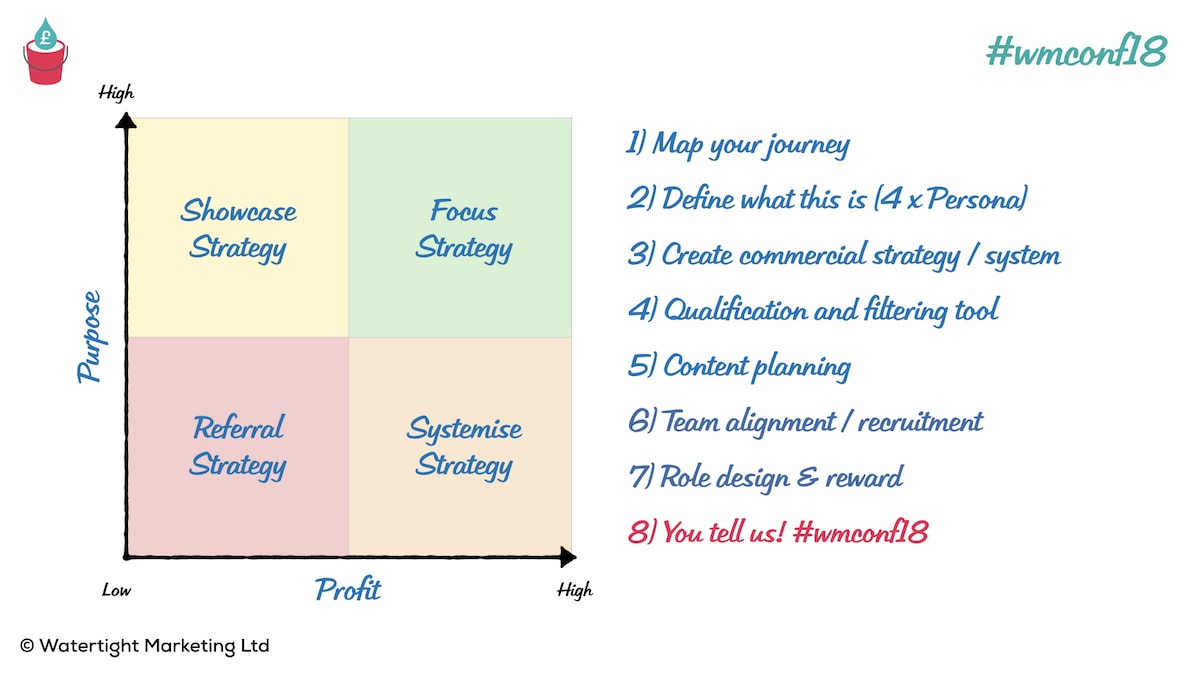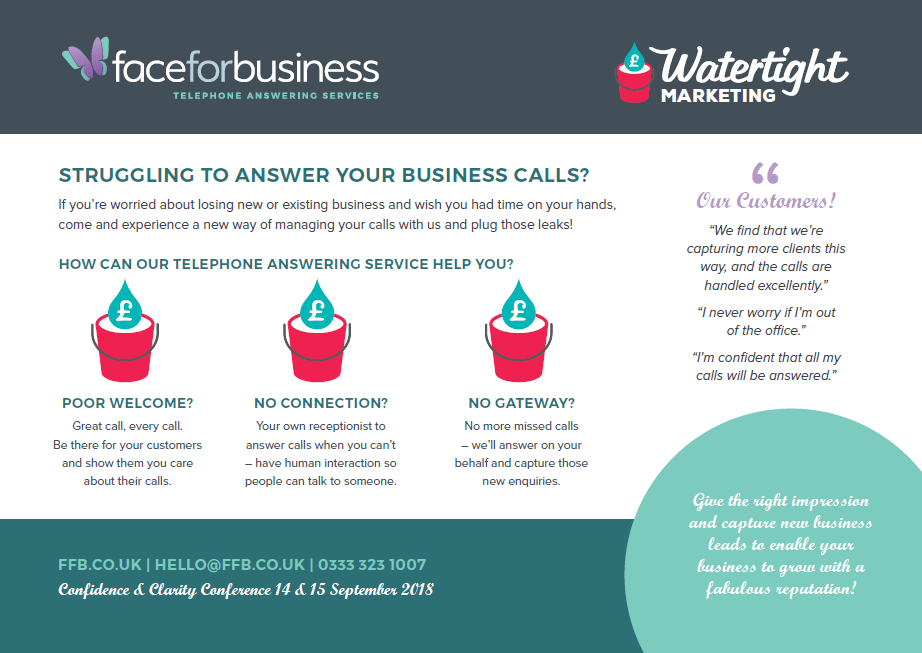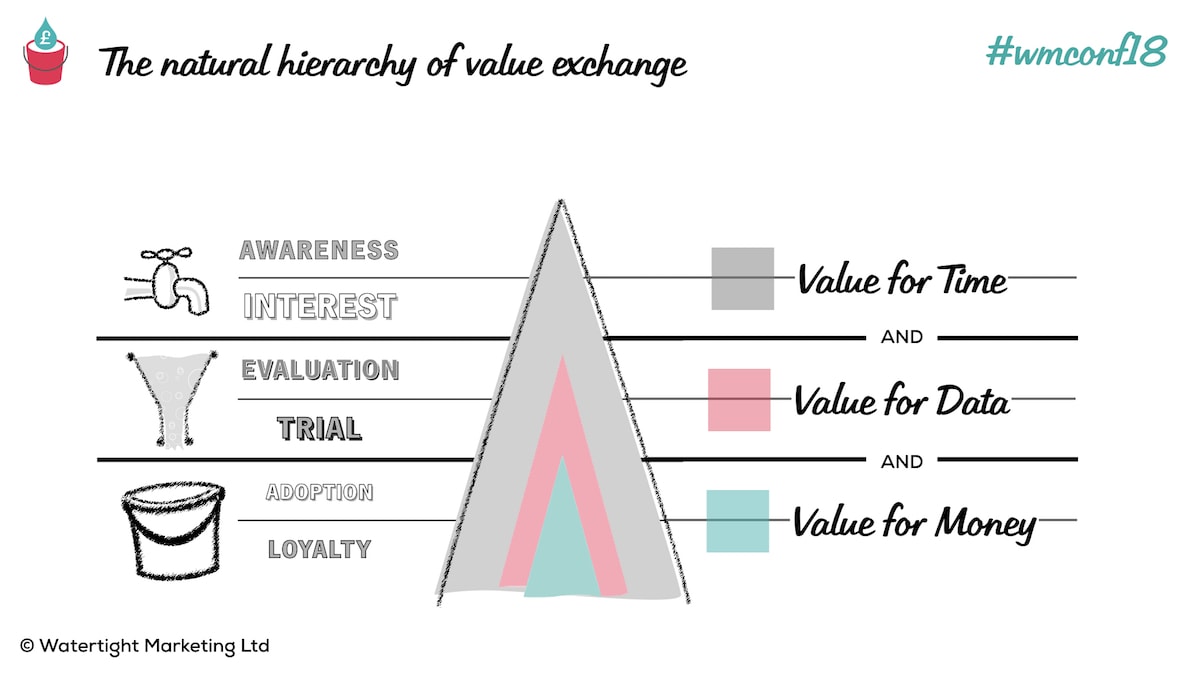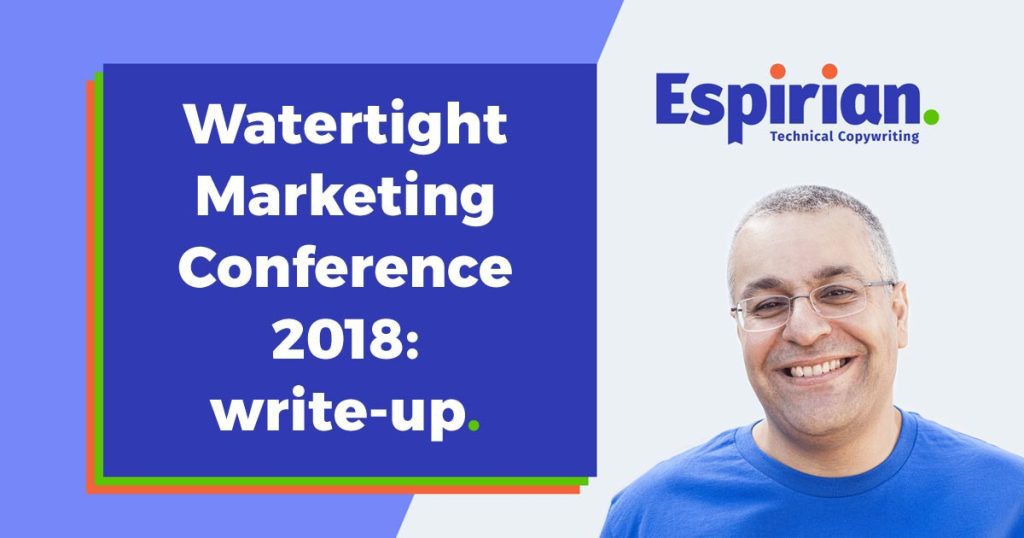The Confidence & Clarity Conference 2018
This write-up covers the two-day Confidence & Clarity conference run by Watertight Marketing on 14 and 15 September 2018 at the DoubleTree Hilton in Bristol.
- Introduction
- The right kind of work – 4 strategies
- Mapping the way forward with the 4 strategies
- Marketing in action – updates from business owners
- Where to focus your marketing efforts
- Day two – Natural paths to purchase
- Marketing in action – more updates from business owners
- Tips for promoting your business as a source of information for journalists
- Let’s wrap up
Introduction
The Watertight Marketing methodology is the brainchild of Bryony Thomas, and the book of the same name has been helping businesses with their marketing since its release in 2013.
Much of the conference was filled with sessions run by Bryony, who entered the stage on day one to the tune of Demi Lovato’s Confident. (I wasn’t expecting that!)
"Confidence is an act you do and then feel afterwards."
Kicking off the Watertight Marketing conference is @bryonythomas #wmconf18
— John Espirian (@espirian) September 14, 2018
Bryony started by introducing other master practitioners of the Watertight Marketing methodology, and provided an intro to what Watertight Marketing is all about.
Rather than the classic funnels analogy, Watertight Marketing uses the concept of buckets, funnels and taps – and only the last of these is what we’d consider as traditional marketing activity.
"Watertight tools help people out-think rather than out-spend the competition." @bryonythomas #wmconf18
— John Espirian (@espirian) September 14, 2018
The right kind of work – 4 strategies
We started by learning about doing the right kind of work, using a 2×2 ‘purpose and profit’ grid to categorise the work we really want to do versus the stuff that doesn’t inspire us or help to pay the bills.
This activity leads to 4 strategies:

Strategy 1: Referral
for work we don’t want to do and that doesn’t pay well.
This strategy is for clients who might be giving us work that isn’t part of our core service. They’re typically unaware of what our core service is, and they don’t have much money to spend.
The best approach is to refer such clients to others, to leave room for the people we really do want to work with.
As well as pointing these clients elsewhere, there are other ways to help them make good decisions:
- publish your values on your website, so that it’s easy for people to see whether they’re aligned with what you do.
- provide affiliate links to books and other self-help resources.
- use questionnaires and tools to help people self-qualify.
Strategy 2: Systemisation
for work we don’t want to do but that does pay well.
This strategy is for clients who have money but who might be a drain on our energy or whose work doesn’t inspire us at all.
The reality is that most businesses have to do this sort of work, especially in the early phase of establishing themselves.
It’s best to systemise as much as possible by putting in good processes that mean you don’t have to be too ‘close’ to the work.
If possible, develop a product or even a sub-brand that could appeal to such clients (who pay well, remember). This could help you distance yourself and retain your energy for the clients you really do want to work with.
If you put your personality into your content (and you definitely should do that), it might help these clients to realise that you’re not the best fit for them.
Strategy 3: Showcase
for work we do want to do but that doesn’t pay well.
This strategy is for clients you’d love to work with but who can’t pay your bills. In this case, you need to extract as much value from the working relationship as possible.
OK, the client can’t pay much, but your value exchange could involve things like getting testimonials, backlinks and social mentions that raise your profile.
Perhaps you can also get some free products or service subscriptions that would be cheap for the client to provide.
If experimentation and research interests you, your low-paying client might be willing for you to test products and services on them. This sort of data could help you provide a better experience for the clients who are willing to pay you top dollar.
If services are given at a lower rate than normal, it’s important to bill for the full amount and indicate a discount on the invoice. That way, there are no quibbles if the client wants to hire you in future when they have a bigger budget.
You need to show that your services have value, even if a Showcase customer isn’t paying full whack to begin with.
Strategy 4: Focus
for work we do want to do and that pays well.
This strategy is for clients who really tick the boxes – it’s your ideal work and they pay you full whack for the privilege of working with you.
It’s this quadrant of the grid that the rest of the conference was focused on: being known for the work you love and building your core business around the clients who will pay you for your expertise.
If you’re going to go overboard with your service for your clients, these are the ones to do it with.
Mapping the way forward with the 4 strategies
With the 4 strategies above in mind, Bryony talked about how to map out an approach for your business. Here are the highlights:
- Define personas: write pen portraits for each of the 4 customer types, to help you recognise them when they contact you.
- Develop a commercial strategy: think about how best to handle each customer type when they contact you. How can you extract value from each contact? e.g. referring a low-paying client away can be good for your reputation – there’s value even if you haven’t been paid by the client.
- Create a filtering tool: give potential clients a way to qualify themselves in and out of working with you. The more you can automate or systemise this, the better the quality of the contacts you get, hence you can spend more time talking with and serving your ideal clients.
- Plan your content: make sure you produce content that is geared towards the ideal work you want to do (for the clients in the ‘focus’ strategy). Don’t write material about the work you don’t want!
- Align your team: get everyone to understand and agree about how your client profile is sliced up. Don’t risk losing goodwill by getting the same people on your team to deal with difficult customers all the time. Provide a mix of challenges so that your staff stay motivated and don’t burn out.
Bryony mentioned the Watertight Marketing Social Scholar Scheme, which provides a fully funded place on their Masterplan programme for a chosen charity or social enterprise who applies for consideration.
Marketing in action – updates from business owners
Next, we heard from Karen Meager, co-founder of Monkey Puzzle, and Malcolm Miller, CEO of RTS Group.
Karen read the Watertight Marketing book and took her consultancy to capacity after only 3 years, with a small team now delivering training to clients.
Her tip was to spend time understanding your clients, and going into detail about what matters to them.
"Focus on the detail of your ideal customer. Go into the minutiae."@KarenMeager at #wmconf18
⬆️ I do this with my clients, too. Here are my tips: https://t.co/uGqqTgan2y
— John Espirian (@espirian) September 14, 2018
Karen reminded us that it can take years to close a sale, so we shouldn’t rush to business. And when collecting feedback from clients, we should ask for practical testimonials that talk about specific changes they’ve been able to make as a result of using our products or services.
Malcolm’s business helps large automotive retailers, and he told of his success via LinkedIn (my favourite platform for B2B work).
"Facebook is where we share our fun stuff. We use LinkedIn for B2B."@rtslearning's Malcolm Miller
⬆️ Me too!#wmconf18
— John Espirian (@espirian) September 14, 2018
The Watertight methodology helped Malcolm’s business by showing him the need to focus on brand identity, a good social and web presence, clear aims and objectives, and solid messaging. Much of this sounds like the fundamentals of effective marketing, but it’s clear that Watertight Marketing has helped give many businesses a structured approach to plugging the leaks in their processes.
Later in the day, we heard from more business owners who had used the Watertight methods in their organisations.
Andy Rogers of Xpedient Print talked about the value of print media in making an emotional connection with clients. Even businesses that are associated solely with an online presence have print activities, too:
- Amazon makes a print catalogue
- Facebook have a magazine
- Google uses direct mail
Andy told us that good print campaigns can generate a higher response rate than their online counterparts, and challenged us to think about the materials we leave behind when visiting clients. A modest investment in print content could make enough of an impact to sway business in your favour, and so it’s worth considering even if your operation runs online.
Andy MacGregor of Face For Business talked about his call-answering service, telling us that the phone is still the largest market for business communications, citing interesting figures from a Vodafone survey:
- 90% of people go elsewhere if a business does not answer their calls.
- 80% of people don’t leave voicemail.
- 74% of people still do business over the phone.
Andy warned us not to outsource call handling unless there is a good mechanism for assessing quality. At Face For Business, this is done via a private portal where customers can listen to how their real calls are handled (a great idea).
Face For Business have produced materials that show how much they’ve taken onboard the Watertight methodology:

John Cassidy of The Headshot Guy talked about the value of good headshots, telling us that people trust and want to see others’ faces when doing business with them. He suggested that customers would be more loyal when they can see your face, and so we should put our faces everywhere, including in our email signatures (something I haven’t done but am willing to try).
John’s top tips for taking a good headshot are summed up in his FACE acronym:
- Flattering
- Approachable
- Confident
- Engaging
Photographers from John’s business were at the event to offer attendees an easy way to get a new headshot done.
Lucy Whittington of Connectably talked about workflows. Lucy’s service was something I had a little knowledge of already, as her business partner, Gareth Everson, is a colleague of mine in the CMA.
Where to focus your marketing efforts
Bryony returned to talk about where to focus our marketing efforts, with practical tips based on our Profit Priority Profile (in beta) reports.
The traditional sales funnel metaphor suggests that everyone you meet will get through the funnel and become a customer.
"There is no sales funnel."@bryonythomas #wmconf18
— John Espirian (@espirian) September 14, 2018
Winning business is like stealing your neighbour's cat. You need to put out a path of treats – but don't expect it to be quick.
You can't steal a cat in a day. @bryonythomas #wmconf18
— John Espirian (@espirian) September 14, 2018
The top tip was to focus on late-stage efforts in converting existing leads into paying customers, as that’s cheaper than ‘turning on the taps’ and getting more traffic upfront.
It’s better to give more attention to people who are almost customers than to try to get completely new people through the door.
Day one closed with premium ticket holders getting headshots done and then attending an evening reception and award ceremony.
Natural paths to purchase
Day 2 started with delegates looking for ‘leak buddies’ – people who faced the same main business challenge, so they could discuss their issues in pair or small groups.
Get your free Profit Priority Profile (in beta) to see where your business leaks are.
Bryony then moved on to talk about steadily earning the right to people’s time, illustrated by 3 types of value exchange.
The aim is to create a series of purposeful steps so that potential customers get the choice to move forward with your service if they wish (this isn’t about forcing people to buy from you).

Exchange 1: Value for time
This is where we try to increase the time people spend consuming our content – but we don’t want to overload them, and we certainly don’t want to rush straight to business.
Bryony reminded us not to ‘propose on the first date’. We should always aim to build relationships slowly before moving on to commitment.
I agree – it’s frustrating when people exchange a couple of messages and then assume you want to do business with them. Stop rushing so much!
In this first value exchange, it’s OK to gather information on potential clients by using a Facebook Pixel or prompting readers to sign up to a mailing list.
Potentially, people may be willing to try a cheap packaged service (moving on to larger amounts or ongoing retainers comes later).
One way to create such a service is to make a named package that acts as an intro to your main service.
Imagine slicing off the first overview module of a training course, for example, and selling that as a standalone item.
Customers may get what they need from this ‘slice’ – or they might be interested enough to want more. Either way, they get the choice.
Examples of this value exchange:
- audits
- pilot studies
- proof of concept reviews
- test projects
- intro courses
- website/copywriting critiques
There are also some incentives to make people more likely to take up such packaged services. For example:
- bundled services
- ‘free’ bonuses
- money-back guarantees
- payment plans
‘Discounts’ were notable by their absence, but Bryony smartly recommended that it’s far better to throw in a bonus rather than offer a discount. Instead, discounts should be offered only as part of the Showcase strategy.
"When working with new customers, throw in a bonus rather than offering a discount."@bryonythomas #wmconf18
— John Espirian (@espirian) September 15, 2018
Exchange 2: Value for data
This is what Bryony called ‘the skim’, where you create content that covers your end-to-end process in brief.
So, if you had a multi-module training course, for example, a skim would be a short intro to each module but without any real depth of content.
Giving people a quick or diagnostic helps them to self-qualify and filter into the right part of the profit/purpose matrix.
Examples of this value exchange:
- rating scales
- benchmarks
- action plans
- gap analyses
- quizzes
- mini-courses
- proposals
- workshops and events
Exchange 3: Value for money/commitment
The final value exchange is about getting your best content to the right people. It’s what we’d usually call good marketing.
People need to see a lot of the same content to remember it, so don’t be afraid to recycle your evergreen content and becoming known around that topic.
Bryony gave the analogy of no one wanting to hear new music from old rockers – people are happy with the greatest hits, so give them what they came for.
Examples of this value exchange:
- tips
- answers
- entertainment
- checklists
- how-to guides
As well as the content, there’s the medium to consider. Again, there are plenty of options:
- blogs
- vlogs
- books
- podcasts
- infographics
- cartoons
- presentations
- animations
An important point is that most or all of your content should be free. Creating content creates the vehicles that show off your expertise. These demonstrate what the journey will be like if customers decide to work with you.
(I liked this point, as I’m all about creating free content.)
Marketing in action – more updates from business owners
The day moved on with us hearing from more business owners who had used the Watertight methodology.
Josef Eliott of Oyster IMS gave his top marketing tips:
- focus on getting your core product right.
- make emotional connections.
- stay consistent with your message across all departments.
- ensure that your customers know all of the things you can do for them.
- keep doing the same core things for your fans.
Hollie Brooks of Audenza told us how Watertight Marketing had helped her build and rebrand her furniture business, which has led to a tripling of profits.
Like Josef, Hollie also talked of the importance of building an emotional connection with customers.
Using one of the best-known tactics in content marketing, Hollie created content that would show potential customers good reasons not to buy from her. This sounds like madness but has been shown to increase trust with buyers. I’ve taken this approach, too: see 5 reasons why you shouldn’t hire me.
Tips for promoting your business as a source of information for journalists
Compere Steve Bustin suggested a few ways to help business owners with their PR:
- expertsources.co.uk – paid
- responsesource.com – paid
- #JournoRequest on Twitter – free but often ‘noisy’
A brief Q&A rounded off the morning of day two. In the afternoon were networking sessions for standard ticket holders and then further workshops for premium ticket holders.
Let’s wrap up
I found the content of day one more useful than that of day two, and the most interesting insights came when Bryony was onstage.
The Profit Priority Profile (in beta) was a useful exercise and has given some things to tweak in my own business. As it’s free, I’d definitely recommend giving it a go.
The Watertight Marketing book contains a lot of good marketing practice, and if you’re someone who likes to learn by analogy (thinking about buckets for services, funnels for sales and taps for marketing), then this could be the approach to help you plug leaks and stop leaving money on the table.
(What feels like common sense to me might be revelatory to you. I’m fortunate to have had good schooling in what makes for effective marketing because of my memberships of CMA and ATOMIC.)
The next Watertight Marketing conference is lined up for 6 and 7 September 2019 (see pre-registration details).
Need coverage of your next event?
Give your conference or event a boost by getting me to do your write-up.
I'll take photos, share live tweets and produce a written summary just like this one.
Check out some samples of my event coverage, then get in touch to see how I can help you put your event on the map.


